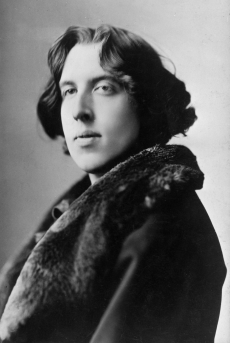
'The Picture of Dorian Gray', Wilde's only novel, is considered one of the great English Victorian works, alongside the works of Austen, and Dickens. Heavily criticized around the time of its publication for depicting the moral descent of a 'golden, fair and fresh faced youth', as well as its 'flippant philosophisings', this novel appeared to gain greater appreciation as time passed. Nowadays, the text is fully recognised for its eloquent depiction of the potential of the human soul, relative to its influence from external forces.
The novel begins in the home of Basil Hallward, or, more specifically, in his art studio. A painter by trade, Hallward is discussing a recent acquaintance of his, with his cynical companion Lord Henry. This beautiful young man, Mr Dorian Gray, has influenced Basil to become even more prolific in his artistic production, leaving Lord Henry desperate to meet the boy. As the popular saying goes - it's all downhill from here.
Henry, upon meeting Dorian, convinces the boy to experience life to its fullest. Dorian begins his life as Henry's protégée, reading from the mysterious 'Yellow Book', and indulging in the expenses the world has to offer. Buying jewels, fabric and experiencing the decadence of Catholicism, Dorian's seemingly innocent, if extravagant, lifestyle, begins to take a darker turn. People who he shares connections with begin to die, whilst all the while, Basil's portrait of the boy starts to change from an angel-like figure, to one of grotesque features.

The novel was published in serial form in 1890, in the American magazine Lippincott’s, before being offered as a full piece in 1891. The slightly hopeless message which the book can be considered to portray; ‘No matter your actions, good or bad, you’ll end up dead’, is in tune with the mood of the British nation during the late 19th century. This feeling, fin de siècle, was associated with a sense of despair, and fear at what the next hundred years would bring. Another reflection of the society of the era the novel offers is a taste of the aesthetic movement. This sect held the belief that beauty was the most important principle in life, all moral principles being secondary. The idea can be seen to be held by several characters in the text, including the three most prominent characters; Dorian, Henry, and Basil. This reflection of the then modern tastes of the era demonstrates Wilde’s commentary not only on society as a whole, but smaller sects, throughout both ‘The Picture of Dorian Gray’, and his other works.
In short, Wilde’s only novel manipulates elements of traditional gothic novels, such as hints of magic, which emphasies his possible social commentary provided in ‘The Picture of Dorian Gray’. The observations of extreme opposites throughout the text, the upper and lower classes, goodness and evil, beauty and ugliness, is reflected in the obsessions of the protagonist himself, as he becomes fascinated with anything in its most radical form. Although Wilde claims that there is no such thing as a moral book, the depictions of the dangers of obsession and influence within the novel could be used to easily argue that this is indeed a moral cautionary tale.
Images used: http://cdn2.hubspot.net/hub/237126/file-1829785647-jpg/oscar-wilde.jpg
http://thepopcan.com/wp-content/uploads/2011/07/dorian.jpg

0 Comment:
Be the first one to comment on this article.